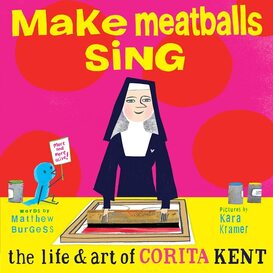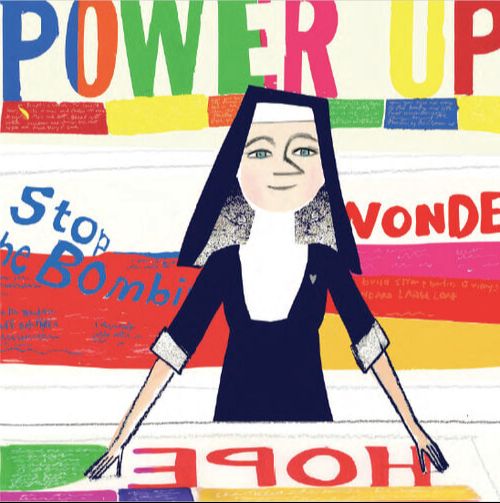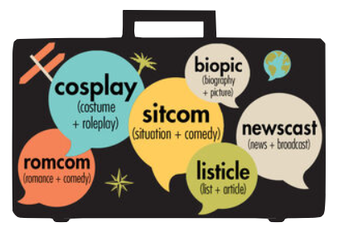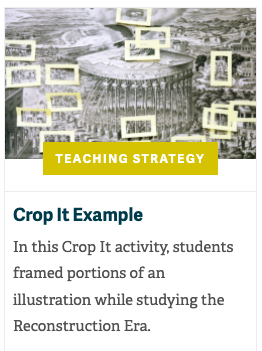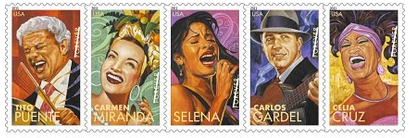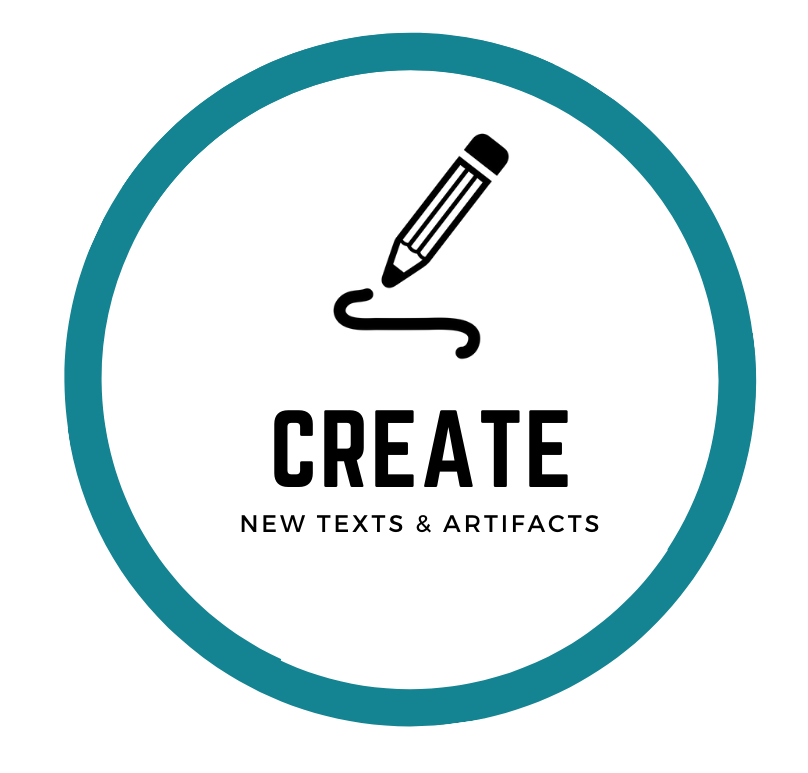|
Entry written by Denise Dávila on behalf of the Biography Clearinghouse.
|
Research & Writing ProcessWho is Matthew Burgess?
Matthew Burgess, Ph.D. is the author of multiple children's books. His biographies include the acclaimed picturebooks: Make Meatballs Sing: The Life & Art of Corita Kent (Enchanted Lion Books, ELB, 2021), Drawing on Walls: A Story of Keith Haring (ELB, 2020), and Enormous Smallness: A Story of E. E. Cummings (ELB, 2015). His fiction picturebooks include Bird Boy (Knopf, 2021), The Bear and The Moon (Knopf, 2020), and The Unbudgeable Curmudgeon (Knopf, 2019). Matthew has been a poet-in-residence in New York City public schools since 2001. He is also an Assistant Professor at Brooklyn College and a contributing editor of Teachers & Writers Magazine. His dissertation examined childhood spaces within the context of twentieth century autobiographies. Learn more about Matthew at http://www.matthewjohnburgess.com/.
|
Who is Kara Kramer?

Kara Kramer is an artist who is happy to be making children's books. She uses a range of media to create her illustrations, which include drawing, collage, and print. Since she was a child, she has enjoyed creating things with her hands. She studied illustration at Washington University before earning an MFA in New York's School of Visual Arts. Her picturebooks include Tell Me a Lion Story (Candlewick Press, 2022)' Make Meatballs Sing: The Life & Art of Corita Kent (Enchanted Lion Books, ELB, 2021), Atticus Caticus (Candlewick Press, 2021). Today, she lives in Brooklyn with her family. Learn more about Kara at https://www.karakramerillustration.com/.
Who is Sister Corita Kent?
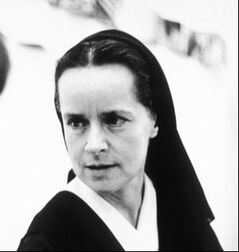
As described by The Corita Art Center of Los Angeles, CA:
Sister Corita Kent (1918–1986) was an artist, educator, and advocate for social justice. At age 18 she entered the religious order Immaculate Heart of Mary, eventually teaching in and then heading up the art department at Immaculate Heart College. Her work evolved from figurative and religious to incorporating advertising images and slogans, popular song lyrics, biblical verses, and literature. Throughout the ‘60s, her work became increasingly political, urging viewers to consider poverty, racism, and injustice. In 1968 she left the order and moved to Boston. After 1970, her work evolved into a sparser, introspective style, influenced by living in a new environment, a secular life, and her battles with cancer. She remained active in social causes until her death in 1986. At the time of her death, she had created almost 800 serigraph editions, thousands of watercolors, and innumerable public and private commissions. Learn more about Corita Kent at: https://www.corita.org/
Sister Corita Kent (1918–1986) was an artist, educator, and advocate for social justice. At age 18 she entered the religious order Immaculate Heart of Mary, eventually teaching in and then heading up the art department at Immaculate Heart College. Her work evolved from figurative and religious to incorporating advertising images and slogans, popular song lyrics, biblical verses, and literature. Throughout the ‘60s, her work became increasingly political, urging viewers to consider poverty, racism, and injustice. In 1968 she left the order and moved to Boston. After 1970, her work evolved into a sparser, introspective style, influenced by living in a new environment, a secular life, and her battles with cancer. She remained active in social causes until her death in 1986. At the time of her death, she had created almost 800 serigraph editions, thousands of watercolors, and innumerable public and private commissions. Learn more about Corita Kent at: https://www.corita.org/
Matthew's Process & Artifacts
|
|
Watch the video interview conducted by Denise Davila to learn more about Matthew's thoughts on researching and Writing Biographies, Collaborating with Visual Artists, Teaching, and Playing.
|
Craft & Structure
Portmanteaus
|
Sister Corita Kent coined the term “plork” to describe the kind of activity where play and work are joined. She created a portmanteau. As described by The Encyclopedia Britannica, a portmanteau results from "blending two or more words, or parts of words, such that the portmanteau word expresses some combination of the meaning of its parts. Examples in English include chortle (from chuckle and snort), smog (from smoke and fog), brunch (from breakfast and lunch), mockumentary (from mock and documentary), and spork (from spoon and fork)."
In the video, Matthew describes a portmanteau activity he and illustrator Kara Kramer facilitated with elementary school students. (See the section of the video associated with the question, "How have your students responded to the publication of your books?".) Matthew and Kara invited students to create portmanteaus that blend the students' first names with words that are synonyms with "awesome." For example, a child named Juan created a portmanteau between Juan and amazing, "Juanamazing." A child named Rhiana blended her name with cool, producing "Coolana." |
Invite students to work together in pairs or teams to brainstorm lists of familiar portmanteaus and to identify how these blended words are used as nouns, verbs, adjectives, adverbs, or other parts of speech. Then, welcome them to create their own portmanteaus between their own names and any other words of their choice. Alternatively, students could create new nouns, verbs, adjectives, or adverbs of their choice. As an extension, students could create an illustrated class dictionary of their new portmanteaus.
|
Epigraphs
|
In writing, as described by MasterClass, an epigraph is "most commonly a short quotation from an existing work" that authors use to establish the theme(s) of their prose or poetry or to locate their story in a particular context. Sister Corita Kent included epigraphs from literature, religious texts, philosophy, and media in her art. For example, her print titled, Bright Bird (1978), which appears at the end of Make Meatballs Sing, features the Hindu salutation, "I greet the light in you." Invite students to examine the epigraphs of Sister Corita's work within Make Meatballs Sing. Welcome them to remove the jacket of the biography to examine the epigraph that appears across the back and front of the picturebook's casing. This epigraph is a short quotation from one of the “rules'' of Sister Corita's art classes: “Consider everything an experiment.”
|
Encourage students to select a textual phrase from Sister Corita's artwork and/or a quote from the list of quotations at the back of Make Meatballs Sing that appeals to them most. They could use the phrase or quote as the inspiration for their own written reflections, poems, or multimodal compositions, like Corita’s, that reflect a blending of text and imagery.
Students could alternately select textual (or visual) phrases that appeal to them from other picturebooks. For example, the phrase “That very night in Max’s room a forest grew” from Sendak’s (1963) Where The Wild Things Are could provide inspiration for an original story vignette, a multimodal composition, or any other creation developed by the students. |
Content & Disciplinary ThinkingMake Meatballs Sing invites readers to think about the capacity of people like Sister Corita Kent to use their creativity, skills, and resources, to "see the sacred in the everyday", to speak out "against injustice, poverty, and war", and to inspire others to "stand up for their beliefs".
|
Nuns: Religious Women with Voices
|
|
Nearly two-thirds of the storyline of Make Meatballs Sing focuses on the period of time in which Corita Kent was a Catholic nun with the Order of the Immaculate Heart of Mary in Los Angeles, CA (1936 - 1968). As described in the picturebook, Sister Corita was a member of a group of nuns who, after Vatican II modernizations in the Catholic Church, "pushed for more reforms" in the Archdiocese of Los Angeles - much to the disapproval and chagrin of the Archbishop. Sister Corita and her peers were recognized for their activism in advancing equality locally and nationally. They were regarded as The Rebel Nuns.
Learn more about the ways these women (re)imagined what it means to be a Catholic nun.
|
Invite students to compare the work, activism, and representation of Sister Corita and her peers, as described in Make Meatballs Sing and other media, with the representation of nuns in fiction and nonfiction picturebooks such as those described below. Welcome students to create graphic organizers and/or multimodal compositions to show the similarities, differences, and/or gaps in the ways these women are constructed in a small set of U.S. picturebooks.
- Madeline (Bemelmans, 1939; fiction)
- Sister Anne's Hands (Lorbiecki, 1998; fiction)
- A library for Juana: The world of Sor Juana Inés (Mora, 2002; nonfiction biography)
Viewfinders: Tools for Social Commentary
|
The centerfold of Make Meatballs Sing features one of the art assignments that Sister Corita gave her students. She asked them to create handheld viewfinders by cutting windows into pieces of cardboard, much like the viewfinder of a camera. Finders serve to focus one's attention on a particular view and to "crop-out" or exclude other content. Like a photographer, Sister Corita was intent on looking at the everyday elements of one's own community. She encouraged her students to "look at ordinary things until the little details came alive". Moreover, she wanted the images she created from everyday elements to have a social voice in the world.
|
Read Make Meatballs Sing alongside a text set of picturebook biographies about photographers whose everyday images have been recognized as commentaries on the social inequalities and injustices of their time. These images include, for example, Dorothea Lange’s “Migrant Mother”. Lange’s famous 1936 portrait of Florence Owens Thompson was excerpted from a series of photographs in the fields of Nipomo, CA. The other photos in the series provide additional information about the site, context, and subject matter than revealed in “Migrant Mother.” Metaphorically speaking, Lange cropped “Migrant Mother” from the series to provide a specific view. Similarly, Sister Corita Kent created metaphorically cropped images to focus viewers’ attention on particular content.
Learn more about Dorothea Lange’s series of Nipomo, CA images via the Library of Congress website: https://guides.loc.gov/migrant-mother Engage students in an image-cropping exercise to explore how artists and photographers can focus viewers’ attention on specific content of a scene by excluding or omitting surrounding imagery. For example, employ a favorite picturebook retelling of the Three Little Pigs or Little Red Ridinghood. First, invite students to identify illustrations in which the wolf might be engaged in deceitful behavior. Second, ask students to cover the wolf’s image with a piece of paper. Third, encourage students to imagine how a reader, who had never before seen the book, would interpret the illustration based on the visual information available to them. With the wolf cropped-out, what story does the image tell? Finally, invite students to create captions for the wolf-free illustrations that suggest a different storyline. Try other photo cropping activities such as the one described by Facing History here. |
After scaffolding students’ understanding about the way cropping can influence viewers’ interpretation of an image, invite them to consider how artists like Sister Corita and photographers, like those featured in the picturebooks below, use the concept of cropping to highlight certain visual information and elicit certain responses from their viewers. How does the content artists and photographers choose to include and exclude shape the meanings and messages of their work?
|
|
Stamps and the U.S. Postal Service
|
As described in Make Meatballs Sing, in 1985, the United States Postal Service commissioned Sister Corita to design a stamp. Her love stamp "reached people all over the world - selling over 700 million" and becoming one of the bestselling UPSP stamps ever. Learn more about Sister Corita's stamp.
Learn more about the U.S. Postal Service and Postage Stamp Artwork
|
Design Stamps
Invite students to imagine the kinds of stamps they would design if they received a commission like Sister Corita Kent. Welcome them to design their own stamps using words and images associated with a theme of their choice (e.g., love, protection of natural resources, youth activism, etc). As an example, see the “Latin Music Legends” stamp series created by picturebook author and illustrator Rafael Lopez. Also, be sure to consult the USPS elementary school curriculum guide, Design It!: Student Stamps for America, for a comprehensive unit on designing stamps relative to the purpose, development, and use of stamps in the U.S. and abroad. Explore Other Elements of the U.S. Postal Service Visit the Educators’ webpage on the Smithsonian’s National Postal Museum’s webpage for an extraordinary array of resources and materials for classroom use. |
Social & Emotional Learning
Rainbow Symbolism
|
As described in Make Meatballs Sing, Sister Corita believed that "the rainbow was a symbol of love, hope, and kindness that unite people across the globe, regardless of their differences". Her 1971 artwork, “The Rainbow Swash”, which was commissioned by Boston Gas for a 140-tank, is the largest copyrighted artwork in the world.
|
Invite students to reflect on the symbolism of rainbows in their lives. Welcome them to share stories, personal or otherwise, about seeing rainbows in nature. What do rainbows mean to them?
Then, use Sister Corita's “The Rainbow Swash” and “Love Stamp” artwork as springboards for discussing the symbolism of the rainbow flag for the LGBTQ+ community. Read about the origin of the rainbow flag in the picturebook biography, Pride: The Story of Harvey Milk and The Rainbow Flag (Sanders, 2018). |
Rainbow Celebrations
|
As described in Make Meatballs Sing, Sister Corita also believed that the public commemoration of special days should be celebratory yet also raise awareness about social justice issues. For example, when she was invited to plan the 1964 commemoration of Mary's Day, which had historically been a solemn event, Sister Corita and her students manifested a "joyful picnic and parade" that was replete with art signage to engage the public in helping to alleviate hunger both locally and nationally. Like a portmanteau, blend Sister Corita's belief that rainbows symbolize love, hope, kindness, and unity among people with her belief that public celebrations are joyous opportunities to advance social justice in learning about Pride Celebration.
|
Examine the picturebook, This Day in June (Pitman, 2014), which invites readers to the San Francisco Pride Parade.
Compare the parade and celebratory illustrations of This Day in June with both the photo and the illustration of the Immaculate Heart College Mary's Day celebration in Make Meatballs Sing. For example, look for the inclusion of children, costumes, music and dancing, signs and banners, and much more. As an extension, consult the Reading Guide at the end of This Day in June for background information about the varying elements of Pride parades in cities like San Francisco. Also see Pitman’s Note to Parents and Caregivers, which provides recommendations for age-appropriate ways to talk with young children about gender identity and sexual orientation. See Matthew Burgess and Kara Kramer's Curriculum Guide for Make Meatballs Sing for additional ideas about creating celebrations. |
New Texts & ArtifactsSister Corita Kent authored provocative multimodal compositions that were inspired by looking closely at ordinary objects and were imbued with intertextual meanings. As suggested in Make Meatballs Sing, much of her work began by focusing her attention on specific elements and blocking out others. She employed cardboard viewfinders with her students as tools for developing the skill of looking. These next activities build upon the use of viewfinders in the classroom. They are adapted from the Make Meatballs Sing Curriculum Guide.
|
If you have 1-2 hours... |
If you have 1-2 days... |
If you have 1-2 weeks... |
|
Make and Use Viewfinders
Invite students to make viewfinders, like those Sister Corita Kent asked her students to create, from everyday materials like recycled cardboard, heavy paper, or cardstock. Encourage students to use their finders to examine things in their classrooms, schools, homes, neighborhoods, and other venues. Take a walking field trip in the vicinity of the school to take a closer look and find unexpected surprises. After returning to the classroom, invite students to write about what they noticed and to discuss their experiences in looking and seeing in a different way. |
Develop a Scavenger Hunt
Invite students to develop a scavenger hunt for another looking tour. Welcome them to generate ideas for their types of objects, shapes, attributes, or other elements they should look on the tour. For example, students might search for things that are green, billowy, jagged, smooth, angular, etc. Encourage students to bring a sketchbook to capture the images they find during the scavenger hunt. Alternatively, they could use digital cameras to document their findings. Upon returning to the classroom, encourage students to identify their favorite "find" from the hunt and to contribute it to a class collage. Students could collaborate in the creation of a visual patchwork akin with the art collage that appears on the back jacket of Make Meatballs Sing. |
Create a Multimodal Composition for Screen Painting
Invite students to use their findings from their scavenger hunts to create multimodal compositions that incorporate images and texts. Present an array of Sister Corita’s prints as models. Encourage students to incorporate epigraphs or quotes from texts that are meaningful to them. Alternatively and/or additionally, invite students to create images based on their looking exercises that could be used for a simple screen painting project. Several resources are available online for creating serigraphy with students. Here is one approach that uses embroidery frames. |
Dávila, D. (2022). Make Meatballs Sing: The Life & Art of Corita Kent. The Biography Clearinghouse.

